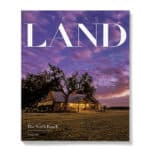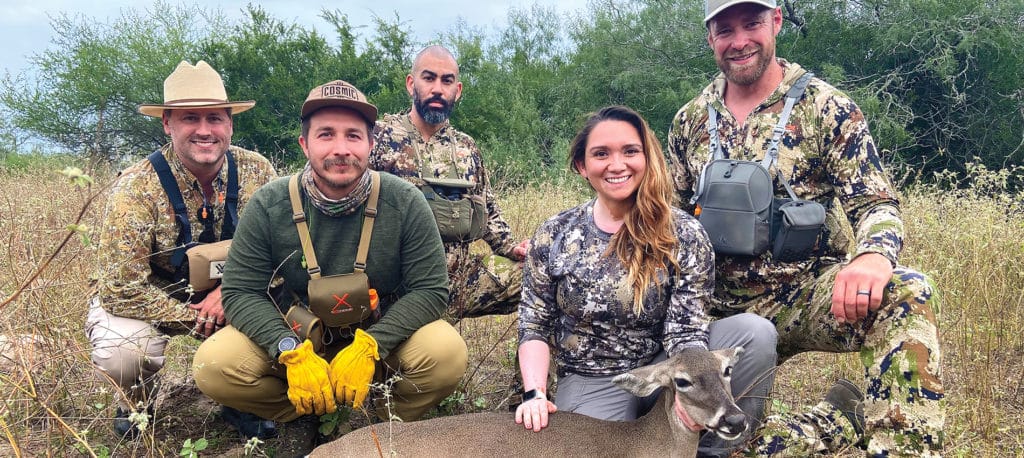
This article is featured in the Spring 2023 issue of Texas LAND magazine. Click here to find out more.
When it comes to hunting, what’s old is new again—and it’s inspiring novice hunters to take to the field to reconnect to the land and their food through TWA’s Adult Learn to Hunt Program.
“Since earliest times, people hunted for sustenance,” said Dr. Matt Hughes, director of the Adult Learn to Hunt Program. “Over the past 60 or so years, the emphasis shifted to recreation. In recent years, though, people have become interested in the origins of their food and this has prompted a whole new group to consider hunting.”
Recognizing the locavore movement as a means of identifying the common ground between sustainable food enthusiasts and hunters, TWA began hosting “Field to Table Dinners” in 2017. The dinners, held in urban areas, featured wild game cuisine and low-key conservation education. At the dinners, one of the most frequently asked questions was: “Where can I learn to hunt?”
The Adult Learn to Hunt Program emerged as an answer to that question. TWA’s long, successful history with the Texas Youth Hunting Program served as the foundation of the new adult-focused endeavor.
“Developing mentored adult hunting opportunities was a natural outgrowth of our ongoing activities, allowing us to capitalize on emerging opportunities,” Hughes said.
For those in the hunting community, the renewed interest in harvesting wild food is an opportunity that fills a need. Recruiting new hunters into the tradition is one of the long-term goals of TWA’s Hunting Heritage Program, which includes the Texas Youth Hunting Program and the Texas Big Game Awards as well as the Adult Learn to Hunt Program.
“The number of hunters as a proportion of the population is shrinking,” Hughes said. “Declining numbers have big implications for the environment and the economy, especially in rural America.”
In 1937, the Pittman-Robertson Act passed and imposed an excise tax on hunting and shooting equipment. The money was earmarked for conservation at the state level. In 2021, hunters generated more than $1.1 billion for conservation nationally; Texas received $71 million of that total.
On the state level, lead wildlife agencies such as the Texas Parks and Wildlife Department, also keep 100 percent of the proceeds from the sale of hunting and fishing licenses to fund on-the-ground conservation. In the 2022 license year, hunters in Texas purchased a total of 852,918 licenses, stamps, tags and permits, which translated into $27.76 million of conservation revenue.
“More hunters equal more conservation funding,” Hughes said.
In addition to funding, more hunters translate into healthier wildlife habitat and populations. With fewer predators on the landscape, populations of game such as white-tailed deer and exotics can grow unchecked. If the number of grazing or browsing species exceeds the land’s natural carrying capacity the habitat can be damaged, which in the long-term leads to weakened and malnourished herds that are susceptible to disease.
Hunting, through the sale of hunting leases or guided hunts, also produces revenue for private landowners. The income stream not only funds additional private conservation but strengthens the ranches’ bottom lines. Economically viable ranches are better equipped to withstand the forces that are driving fragmentation, the sub-division and subsequent development of large tracts.
“Texas is losing 640 acres of working land every day,” Hughes said. “Working lands not only provide food and fiber, but wildlife habitat and essential ecosystem services such as carbon storage, oxygen production and water capture and cleaning. As a society, it’s in our best interest that these lands keep working—and hunting helps them do just that.”
Hunting’s economic punch is felt far beyond the fence lines of individual ranches. According to the 2018 edition of “Hunting in America: An Economic Force for Conservation,” produced for the National Shooting Sports Foundation, hunter spending generates more than $185 million per day for the U.S. economy. And this number does not account for inflation or the post-COVID uptick in participation. Nor does it include the cost of travel to and from hunting destinations, which generates an additional $3.2 billion annually.
The expenditures trickle through the economy at the national, state and local levels. Along the way, the money supports a host of industries and translates into jobs, which further multiplies the impact. Every fall, small towns across Texas bedeck Main Street with banners reading, “Welcome Hunters.”
As TWA CEO Justin Dreibelbis said in an earlier article, “Rural Texas needs hunters. Hunters need rural Texas.”
Adult Learn to Hunt Program
Because the hunting tradition is valuable on so many levels, the hunting community, including NGOs and state and federal wildlife agencies, have joined forces in an initiative known as R3 (recruitment, retention and reactivation). In the broad-based national effort, novice adult hunters such as Matt Rand of Austin are coveted recruits because they, unlike youth hunters, have the means and ability to enter the hunting community immediately once they master the basic skills.
Rand, a senior marketing director for an international real estate data company, was reared in St. Louis, Missouri. Although his maternal grandparents lived in the city, they maintained a huge vegetable garden, raised chickens, preserved food and exposed him to the self-reliant, can-do spirit endemic in the country. His paternal grandparents immersed him in art, music, theater and the like.
“The experience made me well-rounded, but it left me yearning to spend time outdoors,” said Rand, noting his mother’s brother worked for the Missouri Conservation Department and was an avid deer hunter. “I grew up hearing about hunting, but never got to experience it.”
Instead, he answered the call of the wild with mountain biking, hiking, angling, whitewater rafting, shooting sports and archery. Eventually life brought him to Texas, where he met his wife, Penny. She had been reared in Longview and watched as male classmates disappeared into the woods from November—January and decided early on she wasn’t interested in being a “hunting widow.”
He respected her wishes. Plus, establishing a career and raising a young family didn’t leave much time for Rand to pursue new hobbies, especially those that had steep barriers to entry.
“I was interested in hunting, but saw no clear avenues to pursue it,” Rand said.
Now, the Rands’ kids are 16 and 20 giving their dad additional free time. The 45-year-old, who is self-diagnosed with “hobby ADD,” began reconsidering hunting.
“I like learning new things, but I’m all in—I want to master the skills and understand how everything fits together,” Rand said. “I’m someone who knows what I don’t know, so the prospect of hunting was intimidating.”
The barriers—inexperience, expense and access to property—remained. Then Grant Taylor, a colleague, asked if he’d like to accompany him on an Adult Learn to Hunt weekend. Rand’s interest, which had always been more about harvesting food and spending time outdoors with like-minded people than bagging a trophy or embarking on a “rack’em and stack’em killing spree,” was piqued.
“My question had always been: How do I get involved in this tradition, learn deeply and be educated enough to pursue it on my own?” Rand said.
Through the program, he could spend a weekend hunting on a private ranch in Texas for the cost of a TWA membership, a hunting license, and the registration fee for TPWD’s Hunter Education course. In exchange, he would get lodging, game-centric meals, conservation education and one-on-one instruction from an experienced mentor, who would serve as his guide throughout the weekend.
“When Grant suggested the program, I found my perfect way in,” Rand said. “Plus, Grant and I share a similar conservation mindset, so I had the chance to experience hunting with ‘one of my people.’”
He took the plunge in 2021 at the Y Bar Ranch in Tilden, Texas. While Rand didn’t take home a whitetail from the hunt, he left knowing how to select the appropriate firearm (the one he brought was ill-suited for deer hunting), understanding the shot placement and breath control necessary to take down a deer in the field, and surviving his first bout of buck fever.
Like many novice hunters, his adrenaline got the best of him when a six-point management buck that he and his guide watched the previous day came within range of the blind. Keenly aware that his unsteady hands increased the likelihood that he would injure the deer instead of immediately felling it, Rand chose not to shoot. His mentor praised his trigger restraint.
“He bragged on me for not pulling the trigger until I felt confident in the shot, which actually made me more confident in the long run,” Rand said. “It was just one part of the comprehensive learning experience.”
With one hunt under his belt, Rand applied again in 2022. He was selected to participate in a hunt on the historic Yturria Ranch near Raymondville, Texas. The hunters would not only have the chance to pursue white-tailed deer but could also hunt nilgai antelope and participate in the landowner’s predator management program.
“I was still nervous about taking an animal’s life because it’s a big decision—as it should be,” Rand said. “If someone isn’t respectful of that, they probably shouldn’t be hunting.”
Over the weekend, Rand took a white-tailed deer, a nilgai and a coyote as part of the predator management effort.
“For the first-time, I understood the Native American custom of thanking an animal for giving its life,” Rand said. “There is a sense of reverence that comes with the harvest that is hard to describe.”
With guidance, Rand field dressed and processed the deer and the antelope into their component parts. Currently, he’s dry curing a nilgai ham in a traditional Italian style among many other preparations.
“Why shouldn’t we know how to do these things? As humans, we have a responsibility to take care of what God has given us and use the resources wisely,” Rand said.
During his time on the ranch, he also came to understand the importance of balance in nature. While he understood the role of hunting in acquiring sustainable food, the idea of hunting as an applied conservation tool was revelatory.
“Without abundant apex predators, how do you keep wildlife populations in balance?” Rand said. “When there are too many coyotes or too many deer or too many of anything, the habitat and the system suffer. That’s eye opening.”
He continued, “As hunters, it’s our job to keep it all in balance. Once you understand that you’re part of the solution, it compels you to keep hunting.”
Apply Yourself
Adult Learn to Hunt Program
Each participant is accompanied by a personal guide/mentor throughout the educational hunt, which typically takes place on a private ranch over three days/two nights. Novice hunters will learn safe firearm use and handling, shot placement techniques and wild game processing techniques, including skinning, butchering and cooking.
Provided:
- All meals with an emphasis on wild game
- Firearms, if necessary, and instruction
- Hunting guide/mentor
- Lodging

